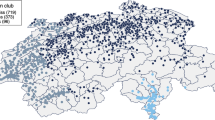Abstract
Social cohesion is a concept difficult to define and to measure. As there can be many definitions, so there can be many measurements. The main problem, either in defining or measuring the concept, is its multilevel and multidimensional nature. At one extreme, country is the most commonly used level to view social cohesion but measurement at this level is of little use for any interventions. At the other extreme, community is the most useful level but it is a social construct for which data are difficult to get, given the administrative boundaries used in social surveys. As an initial attempt to measure social cohesion at a subcountry level, this study focuses on census metropolitan areas for which data on several dimensions of social cohesion are available. We use the information gathered by the National Survey on Giving, Volunteering and Participating (NSGVP) on three dimensions of social cohesion: political (voting and volunteering), economic (occupation, income, labour force participation) and social (social interactions, informal volunteering). Using statistical techniques including factor analysis and standardization, we create an overall index of social cohesion for each CMA. We point out use of this measure for further analysis of social dynamics.
Similar content being viewed by others
References
Berger-Schmidt R. (2000). Social Cohesion as an Aspect of the Quality of Societies: Concept and Measurement. European Union Reporting Working Paper No.14. Centre for Survey Research and Methodology (ZUMA), Mannheim
Bernard P. (1999). Social Cohesion: A Critique. Canadian Policy Research Network, Discussion Paper No.F-09, Ottawa
Blakeley, R.: 1997, Social Capital and Public Policy Development. New Zealand Minister. As summarized in the Social Capital Database at the World Bank web site
Bollen K. A. and Hoyle R. H. (1990). Perceived cohesion: A conceptual and empirical examination. Social Forces 69: 479–504
Buckner J.C. (1988). The development of an instrument to measure neighbourhood cohesion. American Journal of Community Psychology 16: 771–91
Burke, M. and J. Shields: 1999, The Job-poor Recovery: Social Cohesion and the Canadian Labour Market. A Research Report of the Ryerson Social Reporting Network. Ryerson Polytechnic University. Available on the internet at http://www.research.ryerson.ca/~ors/research/job.html
Department of the Environment, Transport and the Regions: 2000, Indices of Deprivation 2000. Available on the internet at http://www.urban.odpm.gov.uk/research/summaries/03100/index.htm
(1998). The Problem of Solidarity: Theories and Models. Gordon and Bleach Publishers, Canada
Durkheim E. (1893 (1965)). The Division of Labor in Society. Trans. by George Simpson. The Free Press, New York, 64
Freeman L.C. (1992). The social concept of “Group”: An empirical test of two models. American Journal of Sociology 98: 152–166
Fukuyama, F.: 1995, Social capital: The problem of measurement. Available from the World Bank Group at http://www.worldbank.org/wbi/mdf/mdf1/socicap.htm
Hirschfield A. and Bowers K.J. (1997). The effects of social cohesion on levels of recorded crime in disadvantaged areas. Urban Studies 34: 1275–1295
Jensen J. (1998). Mapping Social Cohesion: The State of Canadian Research. Canadian Policy Research Network, Study No.F-03, Ottawa
Kearns A. and Forrest R. (2000). Social cohesion and multilevel urban governance. Urban Studies 37: 995–1017
Knack, S. and P. Keefer: 1997, ‘Does social capital have an economic payoff? A cross-country investigation,’ Quarterly Journal of Economics 1997, 1251–1288
Lavis J. and Stoddart G. (1999). Social Cohesion and Health. Working Paper No. 99–09 of Centre for Health Economics and Policy Analysis. McMaster University, Hamilton, Ontario, Canada
Maxwell, J.: 1996, Social Dimensions of Economic Growth, Eric John Hanson Memorial Lecture Series, Vol. VIII, University of Alberta
McCracken M. (1998). Social Cohesion and Macroeconomic Performance. Paper presented at the CSLS Conference on the State of Living Standards and the Quality of Life in Canada, Ottawa
McPherson J.M. and Smith-Lovin L. (1986). Sex aggregation in voluntary associations. American Sociological Review 51: 61–79
Moody J. and White D.R. (2003). Social cohesion and embeddedness: A hierarchical conception of social groups. American Journal of Sociology 68: 103–127
Myles, J., G. Picot and W. Pyper: 2000, Neighbourhood inequality in Canadian cities. Paper presented at the Canadian Economics Association Meetings and CERF Conference, June 2000, Vancouver. Paper available from Statistics Canada at http://www.statcan.ca
Mudrack P.E. (1989). Defining group cohesiveness: A legacy of confusion. Small Group Behaviour 20: 37–49
Putnam R. (1995). Bowling alone: America’s declining social capital. Journal of Democracy 6: 65–78
Portes A. (1998). Social capital: Its origins and applications in modern sociology. Annual Review of Social Sciences 24: 1–24
Rosell S.A. (1995). Changing Maps: Governing in a World of Rapid Change. Carleton University Press, Ottawa
Sennett R. (1998). The Corrosion of Character: The Personal Consequences of Work in the New Capitalism. Norton & Co, New York, 24
Stanley D. (1997). The Economic Consequences of Social Cohesion. SRFA-302, Heritage Canada
Stanley, D.: 2003, What Do We Know About Social Cohesion: The Research Perspective of the Federal Government’s Social Cohesion Research Network
Thomas D. (1999). Indicators of Social Cohesion in Canada. Statistics Canada, Ottawa
Woolley, F.: 1998, Social cohesion and voluntary activities: making connections. Conference on the state of living standards and the quality of life in Canada, Ottawa, Centre for the Study of Living Standards, October 30–31
Author information
Authors and Affiliations
Corresponding author
Rights and permissions
About this article
Cite this article
Rajulton, F., Ravanera, Z.R. & Beaujot, R. Measuring Social Cohesion: An Experiment using the Canadian National Survey of Giving, Volunteering, and Participating. Soc Indic Res 80, 461–492 (2007). https://doi.org/10.1007/s11205-006-0011-1
Accepted:
Published:
Issue Date:
DOI: https://doi.org/10.1007/s11205-006-0011-1




